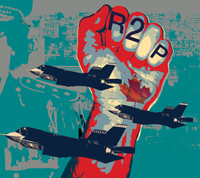 When the international community, including Canada, decided in March to intervene in the Libyan civil war, the stated objective was to protect civilians against the threat of slaughter by leader Muammar Gadhafi. This was the first time Responsibility to Protect, a still-untested doctrine in international law, was so publicly invoked. As the ongoing crisis in Libya demonstrates, intervening under the guise of R2P can be messy business. Nevertheless, having R2P become an accepted principle of law remains our best hope to avoid mass atrocities in the future.
When the international community, including Canada, decided in March to intervene in the Libyan civil war, the stated objective was to protect civilians against the threat of slaughter by leader Muammar Gadhafi. This was the first time Responsibility to Protect, a still-untested doctrine in international law, was so publicly invoked. As the ongoing crisis in Libya demonstrates, intervening under the guise of R2P can be messy business. Nevertheless, having R2P become an accepted principle of law remains our best hope to avoid mass atrocities in the future.
The genesis of R2P lies in the recognition that the international community had repeatedly failed to act in cases such as the 1994 Rwandan genocide. As a result, the idea that nations should intervene on humanitarian grounds gained hold, shifting from the “right to intervene” to the “responsibility to protect.”
Canada played a key role in the birth of R2P when Prime Minister Jean Chrétien announced the International Commission on Intervention and State Sovereignty in September 2000. In 2001, the Commission issued its report, The Responsibility to Protect, which concluded that while it’s a state’s responsibility to protect its civilians, if it is unwilling or unable to do so, the responsibility falls to the international community. In 2005, Canada successfully lobbied 150 UN member states to adopt the R2P doctrine for cases of genocide, war crimes, ethnic cleansing and crimes against humanity.
The uprising in Libya marks the first time the UN formally intervened on the basis of R2P. On March 17th the UN Security Council passed Resolution 1973, which imposed a no-fly zone over Libya and authorized member states to take “all necessary measures” to protect Libyan civilians. This was in large part because of pressure to act from the Arab League.
UN Secretary General Ban Ki-moon said that the resolution “affirms, clearly and unequivocally, the international community’s determination to fulfill its responsibility to protect civilians from violence perpetrated upon them by their own government.”
One of the challenges for R2P is that, because its focus is on protecting civilians, it fails to provide guidance for dealing with the perpetrators attacking them. In an ideal world, R2P interventions would protect civilians and the perpetrators would quickly stop or go away, similar to what happened in Côte d’Ivoire in April when the French military, acting with UN security forces, launched a successful offensive against electorally defeated President Laurent Gbagbo under the guise of “protecting civilians.” Gbagbo soon surrendered and President-elect Alassane Ouattara took power.
Unfortunately, the situation in Libya became complicated and drawn out. Intervention didn’t resolve the crisis within days, as some hoped. Rather, cracks in the coalition began to show and a disconnect developed between the goal of protecting civilians and the desire of many in the NATO-led UN mission for regime change.
In the case of Libya, we were right to intervene. Once Gadhafi announced that he would attack Benghazi with “no mercy and no pity,” there was an imminent threat that thousands of civilians would be massacred.
However, Libya shows that R2P interventions can be tricky. It shows that states must be clear about how they will reach the goal of protecting civilians (not the same as regime change), they must consider how to deal with the perpetrators (what is the role of the International Criminal Court?), and they must be able to explain why intervention is justified in some cases and not in others.
If this happens then R2P could one day become accepted as international law and provide a framework for preventing mass atrocities. Anything less may spell the end of R2P. And that would be a terrible thing.
Catherine McKenna is the executive director of Canadian Lawyers Abroad
Illustration by Peter Horvath

